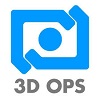
3D Ops provides update one year after “GIGTANK Demo Day”
 (EDITOR’S NOTE: “GIGTANK Demo Day” is scheduled for today in Chattanooga. Ahead of that event, we talked with the President of one of last year’s companies to see where his start-up was a year later.)
(EDITOR’S NOTE: “GIGTANK Demo Day” is scheduled for today in Chattanooga. Ahead of that event, we talked with the President of one of last year’s companies to see where his start-up was a year later.)
By Tom Ballard, Chief Alliance Officer, Pershing Yoakley & Associates, P.C.
“You have to see it,” Keith Campbell of Chattanooga-based 3D Operations, Inc. (3D Ops) told us recently.
The President of the company that graduated from last year’s “GIGTANK” program was drawing an analogy between the 3D Ops product – a patient-specific, 3D-printed model to enhance a surgeon’s preparations – and the planning a runner or golfer does before an event.
“Runners have to visualize a race, just as golfers have to visualize a shot,” Campbell says.
Thanks to the 3D Ops product, surgeons can do more than just visualize the upcoming operation. They actually have a three-dimensional replica of the body area – a heart, brain, kidney, or other organ – as they do their pre-op preparations.
We profiled the start-up in a teknovation.biz post last year.
“We’ve come a long way in hundreds and hundreds of ways,” Campbell says in describing the past 12 months. “We are right on the precipice of some exciting announcements.”
A quick review of the company’s website shows the use of four words to describe the product offering. Those words are:
- Capture (“We facilitate a secure and HIPAA-compliant acquisition of your MRI or CT scans.”)
- Convert (“Our patent-pending tools convert your MRI/CT scans to 3D printable files, customized to your surgeon’s desires.”)
- Create (“3D Ops utilizes the most advanced 3D printers available to create patient-specific anatomical replicas.”)
- Deliver (“Our rapid delivery to surgeons for pre-surgical planning is within hours, always with our quality guarantee.”)
For Campbell and the 3D Ops team, their passion is focused on helping hospitals and surgeons increase patient outcomes and satisfaction while also reducing readmissions and costs. In the case of hospitals, it is a large but also constrained market.
Campbell says there are 5,573 hospitals in the United States, including about 400 teaching institutions. With the possible exception of the latter, he says “very few have the ability to adopt the power of 3D printing technology.” That’s where 3D Ops enters the picture.
The company has adopted a model similar to a national chain like FedEx Office or the UPS Store that provides printing, copying, and binding services from a local or regional location. Each store has a variety of copiers and printers to serve a customer’s specific needs.
The 3D Ops model calls for secure offices strategically located in a community or region that can quickly and efficiently serve up to 12 hospitals each. Every location will meet strict standards for privacy of patient information while providing the type of printers needed for the best 3D-printed models. Participating hospitals will pay a small monthly subscription plus the cost of the materials used in the printing process.
“Our business is extremely scalable with the regional model,” Campbell says.
Plans are in the works for a big pilot project to launch soon with seven different focus areas like urology and other soft tissue anatomy. “We’re extremely focused on soft tissue” Campbell says, noting that soft tissue images are much more challenging, appearing mostly in different gradients of grey.
In today’s healthcare environment, quality of service improvements to enhance patient outcomes is certainly a mainstream issue. 3D Ops is now delivering their patented technologies and services to improve personalized medical care and patient outcomes.
Like what you've read?
Forward to a friend!

